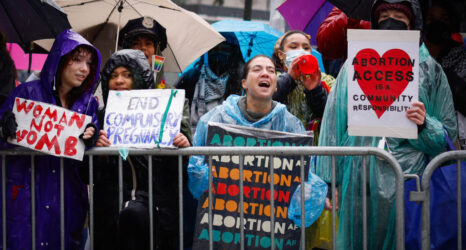Today marks 42 years since the Supreme Court’s landmark decision in Roe v. Wade, which made abortion legal. Despite the long-ago ruling, anti-abortion lawmakers and extremists continue to target abortion access—both in the halls of Congress and on the ground at clinics.
New research from the Feminist Majority Foundation (publisher of Ms.) reveals that clinics and doctors are faced with daily threats and intimidation, reducing women’s access to critical reproductive care and putting doctors’ and clinic workers’ lives on the line.
Says Eleanor Smeal, president of the Feminist Majority Foundation:
More than four decades after the Supreme Court ruled abortion legal, doctors and clinic workers should not have to fear extremists’ attacks as they provide critical women’s health care.
Below is an excerpt from the forthcoming Winter 2015 issue of Ms. highlighting some of FMF’s most startling findings. Subscribe to Ms. to read more and never miss an issue!
Before Dr. George Tiller, an abortion provider in Wichita, Kansas, was shot to death by an anti-abortion extremist in 2009, he faced persistent threats and intimidation. Anti-abortion radicals stalked him and his family, harassed him at home and at his church (where he was eventually killed) and plastered “wanted” posters—featuring his name, photo and address—all over town.
At that time, a little more than one-quarter of abortion clinics reported similar kinds of threats and intimidation by anti-abortion extremists. But now, according to data from the Feminist Majority Foundation’s 2014 National Clinic Violence Survey, those numbers have shot up to nearly 52 percent of clinics.
“The spike in serious threats and coordinated intimidation by extremists is of grave concern,” says duVergne Gaines, director of the Feminist Majority Foundation’s National Clinic Access Project. “We know there is a connection between threats like wanted-style posters, residential targeting of physicians and serious violence, because these types of threats preceded the murders of doctors in the ’90s and Dr. Tiller in 2009.”
The survey of 242 clinics by FMF (publisher of Ms.) shows that nearly 18 percent of clinics found that their doctors’ pictures and personal information had been posted online, while 8.7 percent of clinics reported that doctors had been stalked.
Twenty-eight percent of responding clinics reported that pamphlets featuring photos of their doctors and clinic staff had been distributed, including some titled “TheKillers Among Us,” and the use of wanted-style posters was reported by7.7 percent of clinics.
There’s some heartening news, though: The survey found that the number of clinics experiencing the most severe types of anti-abortion violence—blockades, invasions, bombings, arson, chemical attacks, gunfire and more—decreased from 23.5 per-cent in 2010 to 19.7 percent in 2014.
Additionally, the survey found that a positive relationship with local law enforcement correlated with lower rates of violence and harassment. Of the surveyed clinics that highly rated their relationship with local law enforcement, 55 percent said they’d experienced no incidents of anti-abortion violence and harassment, while just 41 percent of clinics with a “fair” or “poor” police relationship said the same.
Still, nearly 1 in 5 clinics experienced severe anti-abortion violence, which is why Gaines says there’s a “clear need” for law enforcement to vigorously prosecute criminal threats. She says, “Stopping the threat of violence before it becomes actual violence is critical.”
Want to help keep clinic workers and doctors safe? Make a donation to the National Clinic Access Project.





